Interpreting New Data on Africa’s Groundwater
Ever wonder what we’re working on behind the scenes here at Circle of Blue?
This is the first of a new multimedia series from our editorial staff. We’re hoping that by better getting to know each of our team members — what we’re reading, what data we’re playing with, what recent report has piqued our interest — that our readers will feel more engaged. Whether we’re in the office or in the field, you’ll hear from us before the big story publishes. Below you’ll find my thoughts on a recent report on Africa’s groundwater that published last month…
–Aubrey Ann Parker
Assistant Editor
——————————————————————————————————————
This BBC article, tweeted to our our @circleofblue account, gives the results of a new report by the British Geological Survey (BGS) and the University College London’s Department of Geography (UCL) that contains the first quantitative, continent-wide maps of aquifer storage and potential borehole yields in Africa, based on an extensive review of available maps, publications, and data.
I haven’t read the entire report yet, just perused it, but just these are my initial questions:
- Is it a problem that there is often a large difference between the “best estimates” and the “range” of estimated groundwater storage?
- Don’t we need to be comparing this new-found abundance of reserves with total use and with total annual renewable resources, so that we could predict how long these reserves could last into the future?
- How did the figures “100 times” more than the annual renewable resources and “20 times” more than African lakes” come about? Were the “best estimates” used?
- Why do we conclude that these new-found reserves are good news for Africa re. climate change as long as current rates of use continue… Why would we assume that?

Theoretically, if we knew all three of these statistics — groundwater reserves, total use, total annual availability — couldn’t we project how long these reserves would last? And, furthermore, couldn’t we run the simulations under different scenarios (more on that in point #4)? It seems like the paper’s conclusion lacks this analysis, because it essentially just states that there is more water beneath the continent than we had previously thought.
“The volume of groundwater is estimated to be 0.66 million km^3, more than 100 times the annual renewable freshwater resources, and 20 times the freshwater stored in African lakes.” –Conclusions section
It seems like it would be a difficult thing to say definitively “100 times” and “20 times” more, if these figures were based on a “best estimate,” especially since the ranges were so large (as I mentioned in point #1). The report does offer an estimated range of uncertainty, but, again it seems quite a large range to me, though perhaps that is because I have a hard time visualizing a million cubic kilometers.
“The total volume of groundwater in Africa is estimated to be 0.66 million km3 with a range in uncertainty of between 0.36 and 1.75 million km^3. Not all the groundwater volume estimated by the saturated thickness and effective porosity of the aquifer is, however, available to be abstracted.” –Results and Discussion section
“…Our work shows that with careful exploring and construction, there is sufficient groundwater under Africa to support low yielding water supplies for drinking and community irrigation…. So at present extraction rates for drinking and small scale irrigation for agriculture groundwater will provide and will continue to provide a buffer to climate variability.” –Dr. Helen Bonsor, BGS, to the BBC
“African water supplies may be more resilient to climate change than was thought.” —BBC
Why would we assume that the entire continent would continue to use the same amount of water? As we’ve seen with developing Asian economies that are becoming industrialized, water use has shot through the roof with increased energy and even just dietary changes to more meat products. Can’t we assume the same thing for the African nations? Or, at the very least, with the Millennium Development Goals — and with various philanthropic work — can’t we assume that there is going to be an increase in water use if we get water to the 780 million people still without it? (Not to mention getting sanitation to the 2 billion without it. Think about all those additional flushing toilets!)
In other words, I would have liked to have seen the report and/or the BBC article comparing the new-found reserves with the current rate of African water use, as well as how much it is expected to increase.
Likewise, can’t we make similar projections about increasing population causing increased usage? For example, once we begin eliminating water-borne diseases on the African continent, won’t the population start dramatically increasing,?(Currently about 6,000 children die globally each day from a water-related disease.)
Click on the first two images above to enlarge a map Africa’s groundwater reserves and a map of Africa’s aquifer productivity and depth, respectively. Click the third image above to enlarge a graphic with water facts, including that 6,000 children die globally each day from preventable water-related diseases.
Maps courtesy of Environmental Research Letters. Graphic © Hannah Nestor/Circle of Blue.
NOTE: For the groundwater storage map, I’m assuming this is the “best estimate” numbers, though I’m unsure. The bar chart compares the renewable water recharge rate in light green with the groundwater storage in dark green, but I find the bar chart to be a bit misleading, probably because I’ve never really been a big fan of logaritmic scales — notice that the x-axis does not increase in equal increments, but rather by a factor of 10. In other words, at first glance, it may appear that the error bars are not very large relative to the figures given for total groundwater storage. Conversely, it can make countries like Libya seem to have recharge rates that do not appear as small as they really are… notice that is 0.8 cubic kilometers in light green compared with 100,000 in dark green!
Likewise, the aquifer productivity map shows a rate (L/sec), which appears to be how fast a well could pump if a borehole were drilled. The smaller inset depth map shows that the wells are very deep where the rates are fastest. So my question is, even if the water is there, how difficult would it be to tap (and harvest sustainably/efficiently)? And why would it matter how fast the well could pump?
Nadya Ivanova, one of our reporters, and I picked the brains of three experts — one NASA scientist, one global water expert, and one CEO of an international water nonprofit — about what this big finding for Africa could mean. Here is the response we got from Ned Breslin, CEO of Water for People. We want to know what you think. Email me at circleofblue.org/contact or comment below.
is a Traverse City-based assistant editor for Circle of Blue. She specializes in data visualization.
Interests: Latin America, Social Media, Science, Health, Indigenous Peoples

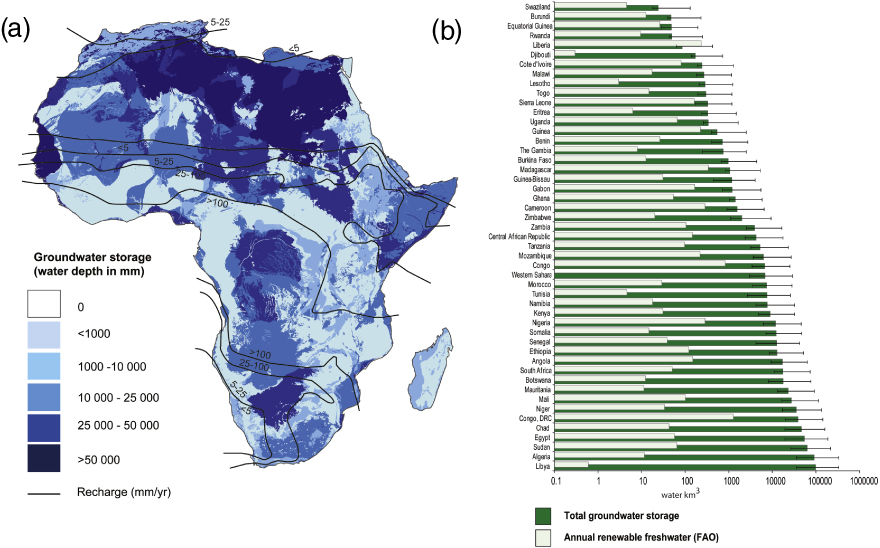

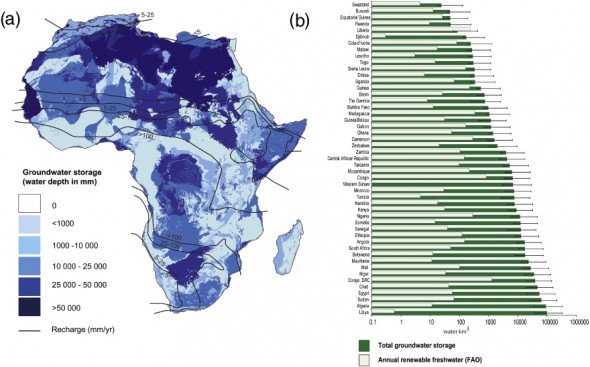
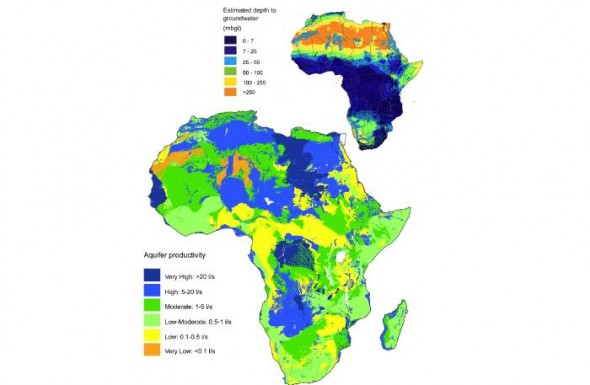
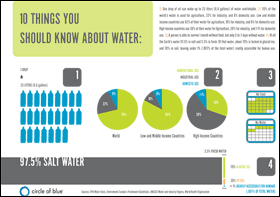








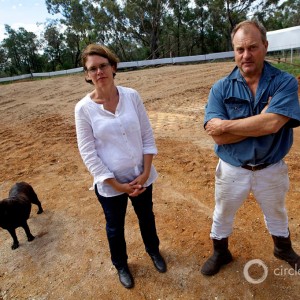
Leave a Reply
Want to join the discussion?Feel free to contribute!